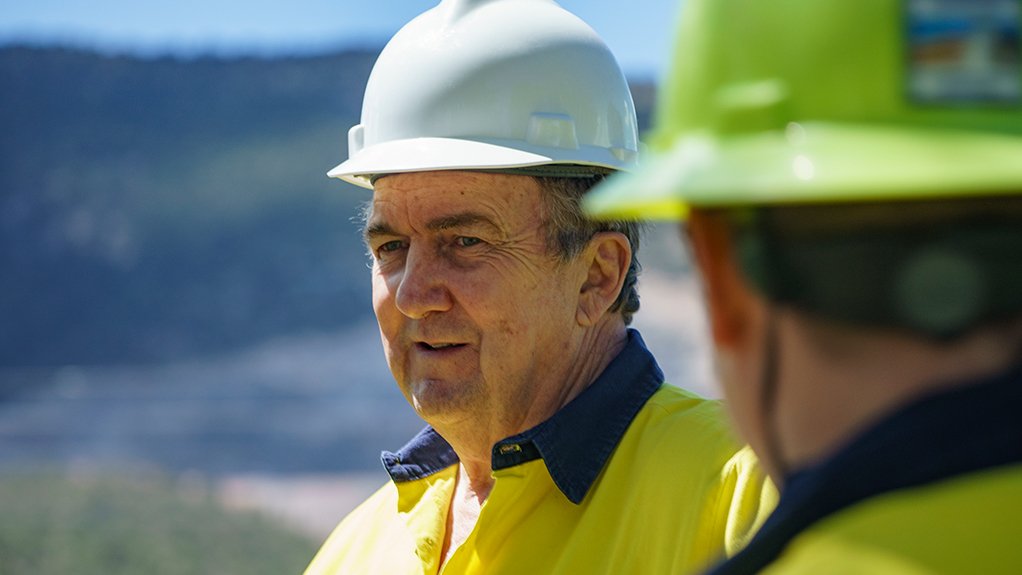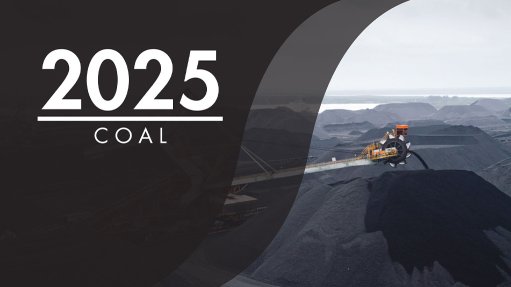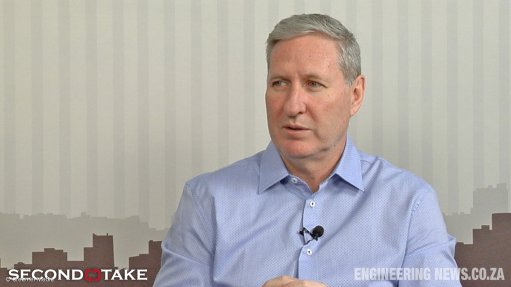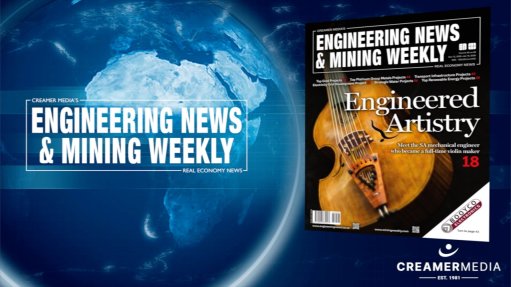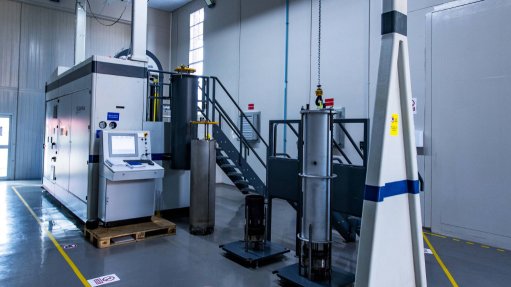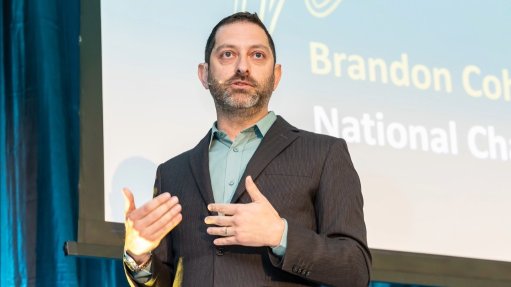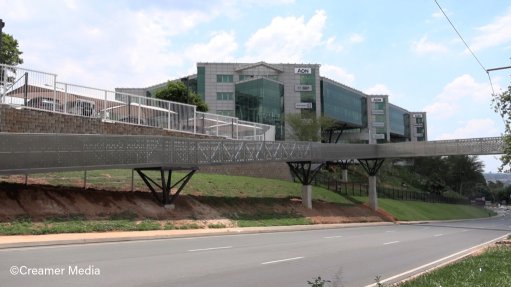Barrick Gold on way to becoming major copper producer
JOHANNESBURG (miningweekly.com) – In less than six years, at the end of the decade, 2030, Barrick will have grown its gold output by 30% and will be a copper miner up there with some of the biggest.
The New York- and Toronto-listed company is already well on its way to the upper 400 000 t of copper a year mark.
This will come about with the expansion at Lumwana in Zambia, which will take the output to the 240 000 t level and then its share of the first round of Reko Diq in Pakistan will add another 100 000 t of copper and 120 000 oz of gold a year.
In Reko Diq’s second phase, the production of this operation rises to 400 000 t of copper and 500 000 oz of gold, of which Barrick shares half.
“Just on those two assets, we're at more than 400 000 t of copper, which puts us into the mid-copper producer category,” Barrick CEO Dr Mark Bristow outlined to Mining Weekly in an interview – and these are low-cost copper pounds. Both operations meet the criteria at $3/ib.
Then, Barrick still has Jabal Sayid in Saudi Arabia and its joint venture with Antofagasta in Chile to add to that.
Only four of the Reko Diq's 14 porphyries are in the mine plan and geologists are currently evaluating the opportunity immediately within the mining licence.
The company has more copper opportunities in Idaho in the US, and copper and gold in southern Peru and also in Ecuador.
Efforts are also under way to secure more opportunities within the Central African Copperbelt.
Mining Weekly: Why are you so confident that 400 000 t of copper a year and 500 000 oz of gold a year will be emerging from Reko Diq and what is the real life-of-mine expectation there?
Bristow: Currently, the life-of-mine reserves are 40 years, but every indication is that it'll go for a hundred years. When you get there, you walk on the mineralisation. It's like going back in time to Escondida and some of these massive Chile deposits, which are now getting to the end of their life, but they've been up for 60, 70 years. Copper deposits on surface like you get at Reko Diq are few and far between. Most of these big copper deposits have very long lead times and require big strips or underground access, like the Mongolian Oyu Tolgoi asset that Rio Tinto has developed. But this one is a simple mine. It's made up of big multiple openpit mines in the Balochistan desert. Its first phase is 45-million processed tons a year, and when it's fully ramped up, it'll be 90-million to 100-million tons a year. So, it's a massive concentrator, effectively, and, we’ll have the first stream operating in 2028, when it will be fully permitted. You just don't get these opportunities to build such big mines so quickly in the world today. If it was in America, that construction would probably take ten to 15 years, just to permit.
During the half-year presentation you referred to a Biodiversity Residual Impact Assessment tool that Barrick launched in the last quarter. What is the assessment all about?
Hopefully, some of our peers will copy it. It's really the same as what we did with our Sustainability Index. I’m of the view that if you're going to embark on something, you should be able to measure it, otherwise why do it? There's greenwashing going on. There's no better example than the gazillion people that have promised delivery of, you know, green vehicles in mining, which has not happened. Everyone created this buzz phrase, nature. We've been at sustainability for a long time and embedded in a proper sustainable mining endeavour has to recognise biodiversity. A good example is Kibali gold mine, where, for instance, biodiversity is today positive relative to what it was when we got there. When we got there, it was full of squatters, who were exploiting the surface gold deposits in a gold-washing endeavour. Now, with all the water properly controlled, there's no discharge out into the environment unless the water is of environmental quality. There is greater biodiversity in the form of fish species, mammals or birds than what was there when we arrived. The world is going to have to pay more attention to biodiversity. I have a passion for this. It's not about protection, it's about managing the biodiversity. You can't stop things going extinct, that's Mother Nature, but you can definitely invest in it, a bit like our reintroduction of white rhino back into the Garamba National Park in the DRC. That's a genuine and significant investment into a world heritage site, which was at risk until African Parks got involved, along with our support. We're doing the same if you take sage grouse in Nevada. We've invested millions of dollars into the re-establishment of sage grouse habitation recognising and researching the way they breed and we're doing a similar, very interesting project with Trout Unlimited now, where we've committed to re-establishing some of the fisheries; that's the whole water system in the upper reaches of the drainage around Nevada operations because you've had the invasion by exotic species such as rainbow trout that put the indigenous cuttroat trout at risk. What we've learned is that if you do that properly, you completely restore the whole water system, and you have to then manage the banks. You restore the whole biodiversity and, as part of this, there are old mine workings that we will rehabilitate as well. If you do it in a scientific way, the land is still usable and the biodiversity is reintroduced. We know that if you respect original habitat and re-establish the biodiversity, the stability and productivity of the land improves. Those are just two examples. I can go on about geckos in the Dominican Republic and water pollution also in the Dominican Republic and in Andean region of Argentina. One of the things that is a core foundational strategy of Trout Unlimited is the recognition that we as normal citizens can reverse some of the negative impacts we've had on our environment in a little way. We felt that that's something that is worth investing in. And again, it’s easy to say you’re going to invest in biodiversity but the next step is how you measure impacts and offsets because this world needs offset investments, so protection of unique ecosystems that haven't been impacted, and whatever you do in a mining site, and by the way, mining impacts a very small part of the world surface, half a percent. But once you have a mine, you can never rehabilitate it back to its absolute original condition and so offset is an important component of managing our environmental impact, and it's becoming an increasingly important way to ensure that we preserve our planet for future generations. So it's a long-winded way of answering a question, but it's an integral part of sustainability within Barrick.
Barrick also has a Formal Benefit Sharing Partnership model pioneered with the Government of Tanzania. What has come out of that so far for the benefit of Tanzania and will this be applied everywhere, including in Mali, where the government is pleading for more from mining?
When I took over Barrick, Tanzania was closed, the President and Acacia company were having a massive fight and Barrick was a 72% shareholder in Acacia and they were fighting over the fact that Barrick and then Acacia, and all the predecessors that have been there since early 90s, hadn't really paid any tax. Well, Barrick chairperson John Thornton started the conversation, and I finished it on how do you share equitably in a national asset because miners mine national assets, and no matter how we own them, it's a national asset. So, my view has always been in Randgold that a 50:50 sharing of the economic benefits is as good as you can get for a partnership, and maybe a country, after 20 years of mining, deserves a little bit more than 50%. Anyway, we settled on a 50:50 true up. We pay tax, but at the end of the year, we make sure that out of every dollar that Tanzania’s got 50 cents, and we got 50 cents, that's after capital, and today, we are the biggest contributor to the Treasury in Tanzania. We moved Barrick from not paying much tax, because it's always easy to hide behind depreciation and accumulated losses and all that sort of stuff, and we did away with that. The motivation is to deliver real value, and then you split it. What I did is I transported that concept to Papua New Guinea when they refused to extend our permit, and it was also the basis on which we settled with the Pakistan government over the arbitration award over Reko Diq. So, to your point, this is exactly the framework on which we are engaged in Mali at the moment.
What is the new tailings project Barrick is developing? Will this be of the dry kind or are you taking the conventional route?
It’s the conventional route for acid sort of drainage type waste. This is in Dominican Republic and as part of our expansion there, we've actually added 20 more years of life to the Pueblo Viejo gold mine, and that's 20 years of plus 800 000 oz/y. To do that, we needed to re-establish a tailings facility, which will be an upstream dam, a full proper dam, because it’s a seismic active area, so it's a big civil construction. It will take the tailings from the processing plants, as well as the waste rock, because we've got to impound it, and the best way to manage that is to put it in under water. It's a big infrastructure project, and it requires relocation of some farmers and various people living in rural areas. We've established proper village towns environments that come with a ready-built house and also access to food security, so either a vegetable garden attached to the place or a secondary small farm, which is accessible from the village. It's a big project that brings community upliftment and also with it comes schools and churches and playgrounds and everything else. It's not only just about building a tailings impoundment but it's about community rehabilitation, effectively.
Why do you see Barrick’s Four Mile gold project as a possible world beater?
The grades come in at plus one ounce a ton, that's 30-plus grams a ton. Some parts are 20 m at 70 g. That’s the sort of quality of asset that the original Carlin discoveries grew and they are the deposits that built companies like Battle Mountain and Newmont and Barrick itself. We hope to have an inventory of around seven to eight million ounces by the end of this year. We've still got a lot of work to do, but the potential resource is significant, maybe four times. When you've got such high grades, it easily supports an underground mine that will produce half a million ounces or more a year for 30-plus years, and that would make it one of the biggest gold mines around and the longest life mines around.
An economist who spoke in Johannesburg recently cited Russia as having gone back to the gold standard. To what extent is Russia using gold as a currency?
Despite all the sanctions, led by the US, Russia has managed better than anyone would have expected, both through the utilisation of gold as a currency and also oil. Russia, along with China, are really driving that de-dollarisation. It’s a real thing and, by the way, the whole world is de-dollarising. That's what's driving the gold price because a lot of the emerging markets and central banks are effectively selling dollar reserves and buying gold because the harsh reality of the conflict in Ukraine is that the US has basically cancelled Russia's US dollar reserves. We’ve seen Japan, which used to be a big owner of US Treasury, sell down its dollar exposure. China, which is the biggest owner of US Treasuries, has been selling down. Then, of course, the BRICS group have been doing the same. There’s been a definite shift to trade out dollars for gold in balancing the central bank reserves within the emerging markets and that's one of the big drivers of the gold price
And, finally, Mark, what, in your view, should be the biggest takeaway from Barrick’s half-year results?
I think the gold industry has been in an interesting place where we've seen a run up in the gold price driven by physical buying and not much investment in either the ETFs or in the equities. Just recently we've seen a change in that. We've still seen the gold price move significantly, but we've seen a renewed interest in ETFs, and there's now been signs of investments in the equities, and Barrick has lagged in that, and that often happens. Randgold lagged a lot in 2011 when everyone was running around buying and doing M&A, but by 2015, we were trading about two times net asset value as we demonstrated that our more cautious, organic focus – and we did some very good M&A, probably the best being the Kibali deal – eventually caught up with the market and overtook it. We've been very disciplined from 2019. We did a number of deals. We took Acacia back into Barrick at market. We did the Barrick/Randgold deal, also at market, and Nevada Gold Mines joint venture was settled, also without anybody paying shares for it, so no premium. Today we had $2 400/oz gold price, so that embedded value that we recognised back in 2019 and 2020, when we did the Nevada transaction, is still very much the driver of value in Barrick. If you took our investment in Nevada gold mine, multiplied it by the Agnico multiple, and then you took an average multiple for the mid-cap copper companies – and most of them are still to deliver like we are – you get to the Barrick market cap today. So, you get the rest of Barrick for minus one-billion dollars. We offer an investment opportunity to people who are long-term investors and want to participate in the value that we’re committed to unlocking. In the fullness of time, you get there. You’ve just got to be determined and patient.
Article Enquiry
Email Article
Save Article
Feedback
To advertise email advertising@creamermedia.co.za or click here
Comments
Press Office
Announcements
What's On
Subscribe to improve your user experience...
Option 1 (equivalent of R125 a month):
Receive a weekly copy of Creamer Media's Engineering News & Mining Weekly magazine
(print copy for those in South Africa and e-magazine for those outside of South Africa)
Receive daily email newsletters
Access to full search results
Access archive of magazine back copies
Access to Projects in Progress
Access to ONE Research Report of your choice in PDF format
Option 2 (equivalent of R375 a month):
All benefits from Option 1
PLUS
Access to Creamer Media's Research Channel Africa for ALL Research Reports, in PDF format, on various industrial and mining sectors
including Electricity; Water; Energy Transition; Hydrogen; Roads, Rail and Ports; Coal; Gold; Platinum; Battery Metals; etc.
Already a subscriber?
Forgotten your password?
Receive weekly copy of Creamer Media's Engineering News & Mining Weekly magazine (print copy for those in South Africa and e-magazine for those outside of South Africa)
➕
Recieve daily email newsletters
➕
Access to full search results
➕
Access archive of magazine back copies
➕
Access to Projects in Progress
➕
Access to ONE Research Report of your choice in PDF format
RESEARCH CHANNEL AFRICA
R4500 (equivalent of R375 a month)
SUBSCRIBEAll benefits from Option 1
➕
Access to Creamer Media's Research Channel Africa for ALL Research Reports on various industrial and mining sectors, in PDF format, including on:
Electricity
➕
Water
➕
Energy Transition
➕
Hydrogen
➕
Roads, Rail and Ports
➕
Coal
➕
Gold
➕
Platinum
➕
Battery Metals
➕
etc.
Receive all benefits from Option 1 or Option 2 delivered to numerous people at your company
➕
Multiple User names and Passwords for simultaneous log-ins
➕
Intranet integration access to all in your organisation



